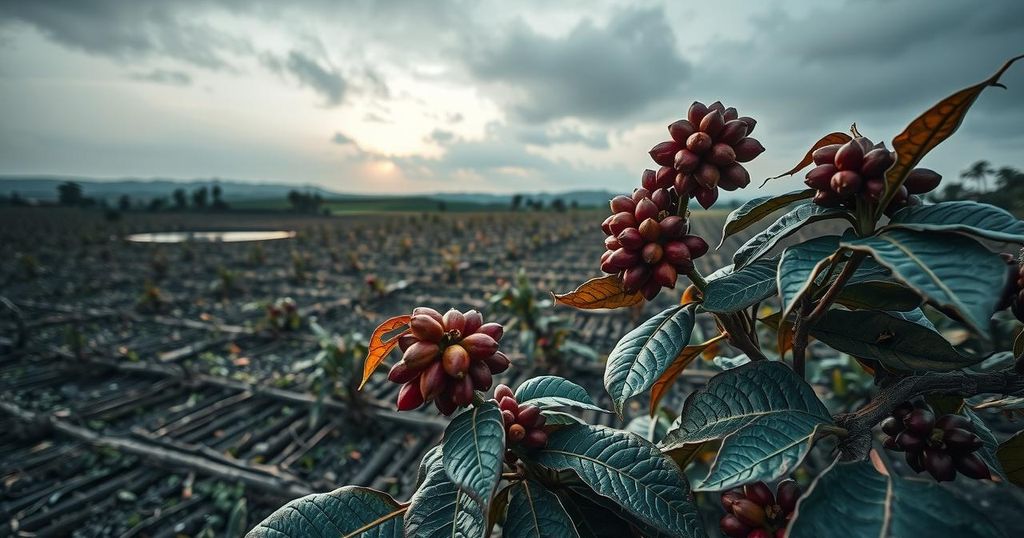Coffee prices increased recently, with arabica and robusta reaching new highs as concerns grow over Brazil’s insufficient rainfall potentially harming yields. Industry inventories are tightening, and sales of the 2024/25 harvest indicate reduced forthcoming supply. Additionally, while global coffee exports rise, potential production decreases are forecasted, signaling mixed prospects for the market.
On Tuesday, May arabica coffee (KCK25) experienced a rise of +11.75 (+3.04%), while May ICE robusta coffee (RMK25) increased by +159 (+2.90%). Coffee prices continued to ascend, with arabica achieving a new 1.5-week high and robusta reaching a 1-week high amid concerns that subpar rainfall in Brazil could impact crop yields. Notably, Brazil, being the leading producer of arabica coffee globally, saw its predominant growing region, Minas Gerais, receive only 11.4 mm of rainfall last week, representing just 24% of the historical average.
The tightening of inventories further supports the rise in coffee prices, with robusta coffee stocks monitored by ICE dipping to a two-month low of 4,247 lots. Additionally, arabica coffee inventories saw a reduction, hitting a 9.25-month low of 758,514 bags, although a recent recovery brought them up to 809,128 bags, a two-week high.
In a positive indication for prices, producers in Brazil have sold a larger proportion of the 2024/25 coffee harvest compared to previous years, with 88% sold as of February 11. This figure exceeds last year’s 79% and is higher than the five-year average of 82%. However, sales for the upcoming 2025/26 crop have lagged, with only 13% sold, indicating a reluctance among producers to market their future harvests.
Supply concerns persist as Cecafe reported a year-over-year decline of 1.6% in Brazil’s coffee exports, totaling 3.98 million bags for January. Conab, Brazil’s governmental crop forecasting agency, predicts a -4.4% decrease in the 2025/26 coffee crop year-over-year, estimating a total of 51.81 million bags. Additionally, the agency has revised down the 2024 coffee crop estimate by 1.1% to 54.2 million bags.
The ongoing effects of El Nino have raised fears of long-term damage to coffee crops in South and Central America. Brazil has endured the driest conditions since 1981, negatively affecting coffee trees, particularly during the crucial flowering period. Meanwhile, Colombia, the second-largest arabica producer, is slowly recovering from last year’s El Nino-induced drought.
Robusta prices, too, are strengthened by reduced production; Vietnam reported a -20% drop in coffee production for the 2023/24 crop year, marking the smallest yield in four years. Although projections suggest a slight dip in Vietnam’s robusta production for the 2024/25 year, exports have also significantly fallen, which may tighten global supply further.
Conversely, reports of increasing global coffee exports hint at a bearish trend for prices. Brazil’s coffee exports in 2024 are expected to rise by +28.8% year-over-year, while Vietnam experienced a +6.3% month-over-month increase in January exports. However, the International Coffee Organization disclosed global coffee exports fell -12.4% year-over-year in December, indicating potential oversupply concerns.
The USDA’s biannual report contained mixed signals. World coffee production may increase by +4.0% during the 2024/25 season, with arabica production rising by +1.5% and robusta by +7.5%. Despite this potential growth, the USDA forecast indicates a decline in ending stocks to a 25-year low of 20.867 million bags, which adds pressure to coffee prices moving forward.
As for the 2025/26 marketing year, Volcafe has downgraded its estimates for Brazil’s arabica coffee production, reflecting an approximately 11 million bags drop from previous forecasts. This suggests a widening global deficit of -8.5 million bags for arabica coffee, continuing the trend of deficits for the fifth consecutive year.
Coffee prices have found support due to reduced rain in Brazil and tightening inventories. Despite some positive news regarding exports, concerns remain over decreasing production in major coffee-growing regions as well as the impact of environmental conditions. Looking ahead, forecasts suggest potential declines in both production and stocks, indicating continued price sensitivity in the coffee market.
Original Source: www.tradingview.com




